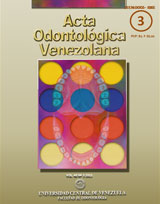LAS FALACIAS DE LA RELACIÓN CÉNTRICA
Keywords:
Relación Céntrica, Oclusión dental, Trastornos ATM, Disfunción de la ATM, Registro de la Relación Maxilomandibular, Centric Relation Dental Occlusion, Temporomandibular Joint Disorders, Temporomandibular Joint Dysfunction Syndrome, Jaw Relation RecordAbstract
El método empleado para validar los argumentos de la Relación céntrica fue en base a silogismos deductivos, las conclusiones fueron apoyadas en premisas con referencias científicas lo que garantiza su relación con los hechos. La revisión bibliográfica se dio conforme aparecían las dudas por despejar. Las conclusiones más resaltantes fueron: La RC no es un estado de contracción Isotónica de los músculos por lo que tampoco es un estado ideal del sistema estomatognático. Todo patología articular relacionada con el desplazamiento anterior del disco esta asociado a una posición superior y posterior del cóndilo mandibular lo que excluye a la posición condilar en MIC de asociarse a problemas articulares. Se infiere de manera inmediata, que si la MIC es lo contrario a la posición posterior superior del cóndilo, entonces no es una posición que produce desplazamiento anterior del disco. Entonces, es una posición protectora ya que no sobrecarga la ATM por ser contraria a la posición hallada en los estudios clínicos. El estado ideal del cóndilo mandibular estaría asociado al Espacio Libre Interoclusal (ELI) por el equilibrio muscular. Pero se sabe que es una posición variable y asociada a factores funcionales, sistémicos, biotipo, tensionales, etc.
The used method to validate the arguments of the central Relation was on the basis of deductive syllogisms, findings were reclined what your relation with the facts guarantees premises with scientific references. The bibliographic revision took place agreeable the doubts to solve appeared. The noteworthiest findings were: The RC is not a status of isotonic contraction of the muscles so that a system's ideal status is not stomatognathic either. Everything articular related pathology with the previous displacement of the record this once a superior and posterior position of the mandibular condyle was associated to what you exclude to the condylar position in MIC of associating to articular problems. We can infer of immediate way, that if the MIC is the opposite to the posterior superior position of the condyle, then it is not a position that produces previous displacement of the record. Then, she is a protective position since you do not overload the NICE to be contrary to the position found in the clinical studies. The ideal state of the mandible's condyle would be associated in favor of ( ELI ) the muscular equilibrium to the Interocclusal Clearance. But he is known that a variable and associated to position is functional, systemic factors, biotype, stress, etc.

